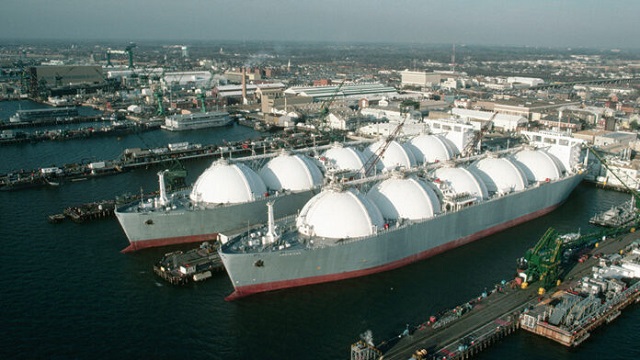Energy
Texas Legislative Committee Proposes Ways to Protect, Expand LNG Industry

From Heartland Daily News
By Bethany Blankley
“the Biden Administration’s federal permitting pause during a presidential election year appears to be purely political in nature and an attempt to disrupt Texas’ booming economy, now the eighth largest economy in the world…. it is abundantly clear American LNG is in the best interest of the Texas economy, local communities, our national security, and global energy security.”
A state legislative committee is proposing ways to expand Texas’ liquified natural gas (LNG) industry after the Biden administration announced it was pausing pending applications for LNG exports that would significantly impact Texas.
The Texas House Select Committee on Protecting Texas LNG Exports issued its findings after holding a hearing on the topic earlier this month. Led by state Rep. Jared Patterson, R-Frisco, the report states, “the Biden Administration’s federal permitting pause during a presidential election year appears to be purely political in nature and an attempt to disrupt Texas’ booming economy, now the eighth largest economy in the world.
“It has caused long-term uncertainty for both investors and allied nations around the world relying on American energy, particularly in Europe as they seek to wean themselves off Russian natural gas. After multiple studies across Democratic and Republican presidential administrations, it is abundantly clear American LNG is in the best interest of the Texas economy, local communities, our national security, and global energy security.”
House Speaker Dade Phelan, R-Beaumont, created the select committee and charged it with evaluating the impact on the Texas LNG industry and to propose actions the state legislature could take in the next legislative session to protect it.
Phelan’s district is critical to the oil and natural gas industry. It encompasses a region known as the “Golden Triangle,” rich in oil and natural gas production, processing, refining and exports in the southeast towns of Beaumont, Port Arthur and Orange. It includes a key LNG export terminal currently under construction in Port Arthur, where several LNG facilities are also located.
The LNG terminal, once completed and operational, is expected to have an export capacity of 13 million tons a year. With access to the Gulf of Mexico through the Sabine-Neches ship channel, it represents a $13 billion investment in new energy infrastructure, the report states.
The U.S. leads the world in LNG exports, led by the Gulf states of Texas and Louisiana. In 2017, the U.S. became a net exporter of natural gas for the first time since 1957, “primarily because of increased LNG exports,” according to the EIA. The U.S. became a net exporter after Cheniere Energy was the first to export domestically sourced LNG from the Sabine Pass LNG Terminal in Cameron Parish, Louisiana, and from the Port of Corpus Christi in Texas, The Center Square first reported.
Nearly 25% of U.S. natural gas reserves are located in Texas and 30% of the largest hundred natural gas fields in the U.S. are in Texas, the legislative report notes, citing state data. It also identifies six LNG facilities nationwide that would be impacted by the ban, including two in Texas, in Port Arthur and Corpus Christi.
Texas ports, including Port Arthur and Corpus Christi, are among the top ports in the U.S. leading in foreign trade impact, and the Port of Corpus Christi continues to break records in tonnage, primarily due to oil and LNG exports, The Center Square reported.
Texas Oil & Gas Association Chief Economist Dean Foreman, who testified before the committee, said, “Texas and Louisiana bear the brunt of short-sighted federal policies that jeopardize LNG export projects, representing potential investments of $200 billion across the value chain, including a projected 20% increase in Texas’ dry natural gas production.
“The reasons given for this pause – concerns about higher domestic natural gas prices, emissions, and community impacts – are clearly unfounded. U.S. LNG exports have responded to global demand, driving domestic innovation that enhances productivity and reduces consumer costs. LNG has replaced coal in power generation, emerging as a primary driver of emission reductions, and have catalyzed economic growth across the Gulf Coast. On all accounts, U.S. LNG exports have proven to be decisively beneficial.”
Two key claims the administration made for implementing the ban (LNG exports increase domestic energy costs and increase methane emissions) have been refuted, The Center Square first reported. A bipartisan coalition of Texas’ congressional delegation called on the president “to refocus on policies that support US LNG,” understanding that Texas is the energy capital of the United States, The Center Square reported. Sixteen states, led by Louisiana and Texas, also sued, arguing the ban is illegal.
The committee recommended that the legislature “consider legislation and policies authorizing the governor to develop and execute an interstate compact with the goal of sharing state information, resources, and services with other interested states seeking to protect and grow the LNG industry along the Gulf Coast.”
It also recommends that the legislature propose legislation and policies to permit temporary eligibility of LNG facility construction grants and loans when federal permitting pauses occur; provide economic incentives for LNG facilities to counter market consequences of a federal permitting pause; reform specific permitting regulations and increase overall permitting process efficiency; expand funding for project construction and development through the Texas Department of Transportation’s Maritime Infrastructure Program; increase workforce grants made available through local colleges to meet workforce demands for construction and facility operations; and mandate that official reports be published every year providing data on the “relevance and importance of the LNG industry regarding the public interest.”
Bethany Blankley is a contributor at The Center Square.
Originally published by The Center Square. Republished with permission.
Alberta
Alberta is investing up to $50 million into new technologies to help reduce oil sands mine water

Technology transforming tailings ponds
Alberta’s oil sands produce some of the most responsible energy in the world and have drastically reduced the amount of fresh water used per barrel. Yet, for decades, operators have been forced to store most of the water they use on site, leading to billions of litres now contained largely in tailings ponds.
Alberta is investing $50 million from the industry-funded TIER system to help develop new and improved technologies that make cleaning up oil sands mine water safer and more effective. Led by Emissions Reduction Alberta, the new Tailings Technology Challenge will help speed up work to safely reclaim the water in oil sands tailing ponds and eventually return the land for use by future generations.
“Alberta’s government is taking action by funding technologies that make treating oil sands water faster, effective and affordable. We look forward to seeing the innovative solutions that come out of this funding challenge, and once again demonstrate Alberta’s global reputation for sustainable energy development and environmental stewardship.”
“Tailings and mine water management remain among the most significant challenges facing Alberta’s energy sector. Through this challenge, we’re demonstrating our commitment to funding solutions that make water treatment and tailings remediation more affordable, scalable and effective.”
As in other mines, the oil sands processing creates leftover water called tailings that need to be properly managed. Recently, Alberta’s Oil Sands Mine Water Steering Committee brought together industry, academics and Indigenous leaders to identify the best path forward to safely address mine water and reclaim land.
This new funding competition will support both new and improved technologies to help oil sands companies minimize freshwater use, promote responsible ways to manage mine water and reclaim mine sites. Using technology for better on-site treatment will help improve safety, reduce future clean up costs and environmental risks, and speed up the process of safely addressing mine water and restoring sites so they are ready for future use.
“Innovation has always played an instrumental role in the oil sands and continues to be an area of focus. Oil sands companies are collaborating and investing to advance environmental technologies, including many focused on mine water and tailings management. We’re excited to see this initiative, as announced today, seeking to explore technology development in an area that’s important to all Albertans.”
Quick facts
- All mines produce tailings. In the oil sands, tailings describe a mixture of water, sand, clay and residual bitumen that are the byproduct of the oil extraction process.
- From 2013 to 2023, oil sands mine operations reduced the amount of fresh water used per barrel by 28 per cent. Recycled water use increased by 51 per cent over that same period.
- The Tailings Technology Challenge is open to oil sands operators and technology providers until Sept. 24.
- The Tailings Technology Challenge will invest in scale-up, pilot, demonstration and first-of-kind commercial technologies and solutions to reduce and manage fluid tailings and the treatment of oil sands mine water.
- Eligible technologies include both engineered and natural solutions that treat tailings to improve water quality and mine process water.
- Successful applicants can receive up to $15 million per project, with a minimum funding request of $1 million.
- Oil sands operators are responsible for site management and reclamation, while ongoing research continues to inform and refine best practices to support effective policy and regulatory outcomes.
Related information
conflict
Middle East clash sends oil prices soaring

This article supplied by Troy Media.
 By Rashid Husain Syed
By Rashid Husain Syed
The Israel-Iran conflict just flipped the script on falling oil prices, pushing them up fast, and that spike could hit your wallet at the pump
Oil prices are no longer being driven by supply and demand. The sudden escalation of military conflict between Israel and Iran has shattered market stability, reversing earlier forecasts and injecting dangerous uncertainty into the global energy system.
What just days ago looked like a steady decline in oil prices has turned into a volatile race upward, with threats of extreme price spikes looming.
For Canadians, these shifts are more than numbers on a commodities chart. Oil is a major Canadian export, and price swings affect everything from
provincial revenues, especially in Alberta and Saskatchewan, to what you pay at the pump. A sustained spike in global oil prices could also feed inflation, driving up the cost of living across the country.
Until recently, optimism over easing trade tensions between the U.S. and China had analysts projecting oil could fall below US$50 a barrel this year. Brent crude traded at US$66.82, and West Texas Intermediate (WTI) hovered near US$65, with demand growth sluggish, the slowest since the pandemic.
That outlook changed dramatically when Israeli airstrikes on Iranian targets and Tehran’s counterattack, including hits on Israel’s Haifa refinery, sent shockwaves through global markets. Within hours, Brent crude surged to US$74.23, and WTI climbed to US$72.98, despite later paring back overnight gains of over 13 per cent. The conflict abruptly reversed the market outlook and reintroduced a risk premium amid fears of disruption in the world’s critical oil-producing region.
Amid mounting tensions, attention has turned to the Strait of Hormuz—the narrow waterway between Iran and Oman through which nearly 20 per cent of the world’s oil ows, including supplies that inuence global and
Canadian fuel prices. While Iran has not yet signalled a closure, the possibility
remains, with catastrophic implications for supply and prices if it occurs.
Analysts have adjusted forecasts accordingly. JPMorgan warns oil could hit US$120 to US$130 per barrel in a worst-case scenario involving military conflict and a disruption of shipments through the strait. Goldman Sachs estimates Brent could temporarily spike above US$90 due to a potential loss of 1.75 million barrels per day of Iranian supply over six months, partially offset by increased OPEC+ output. In a note published Friday morning, Goldman Sachs analysts Daan Struyven and his team wrote: “We estimate that Brent jumps to a peak just over US$90 a barrel but declines back to the US$60s in 2026 as Iran supply recovers. Based on our prior analysis, we estimate that oil prices may exceed US$100 a barrel in an extreme tail scenario of an extended disruption.”
Iraq’s foreign minister, Fuad Hussein, has issued a more dire warning: “The Strait of Hormuz might be closed due to the Israel-Iran confrontation, and the world markets could lose millions of barrels of oil per day in supplies. This could result in a price increase of between US$200 and US$300 per barrel.”
During a call with German Foreign Minister Johann Wadephul, Hussein added: “If military operations between Iran and Israel continue, the global market will lose approximately five million barrels per day produced by Iraq and the Gulf states.”
Such a supply shock would worsen inflation, strain economies, and hurt both exporters and importers, including vulnerable countries like Iraq.
Despite some analysts holding to base-case forecasts in the low to mid-US$60s for 2025, that optimism now looks fragile. The oil market is being held hostage by geopolitics, sidelining fundamentals.
What happens next depends on whether the region plunges deeper into conflict or pulls back. But for now, one thing is clear: the calm is over, and oil is once again at the mercy of war.
Toronto-based Rashid Husain Syed is a highly regarded analyst specializing in energy and politics, particularly in the Middle East. In addition to his contributions to local and international newspapers, Rashid frequently lends his expertise as a speaker at global conferences. Organizations such as the Department of Energy in Washington and the International Energy Agency in Paris have sought his insights on global energy matters.
Troy Media empowers Canadian community news outlets by providing independent, insightful analysis and commentary. Our mission is to support local media in helping Canadians stay informed and engaged by delivering reliable content that strengthens community connections and deepens understanding across the country.
-

 Health1 day ago
Health1 day agoLast day and last chance to win this dream home! Support the 2025 Red Deer Hospital Lottery before midnight!
-

 conflict2 days ago
conflict2 days ago“Evacuate”: Netanyahu Warns Tehran as Israel Expands Strikes on Iran’s Military Command
-

 Aristotle Foundation2 days ago
Aristotle Foundation2 days agoThe Canadian Medical Association’s inexplicable stance on pediatric gender medicine
-

 Energy2 days ago
Energy2 days agoCould the G7 Summit in Alberta be a historic moment for Canadian energy?
-

 Bruce Dowbiggin2 days ago
Bruce Dowbiggin2 days agoWOKE NBA Stars Seems Natural For CDN Advertisers. Why Won’t They Bite?
-

 Crime2 days ago
Crime2 days agoMinnesota shooter arrested after 48-hour manhunt
-

 Alberta1 day ago
Alberta1 day agoAlberta announces citizens will have to pay for their COVID shots
-

 Uncategorized1 day ago
Uncategorized1 day agoKananaskis G7 meeting the right setting for U.S. and Canada to reassert energy ties





